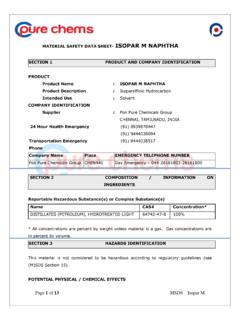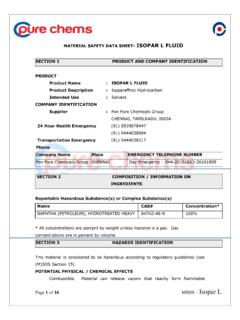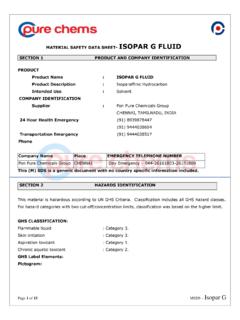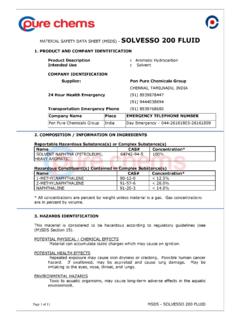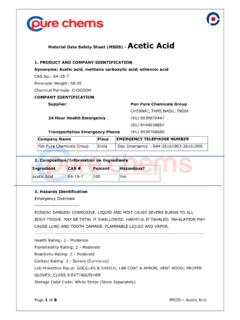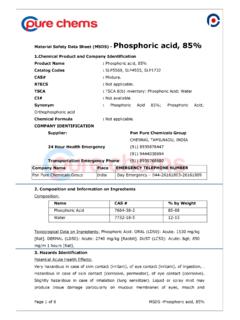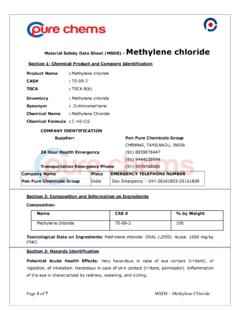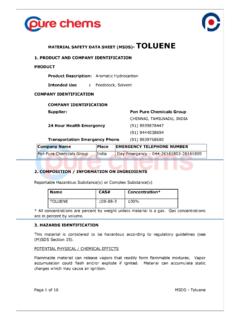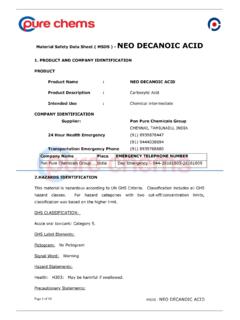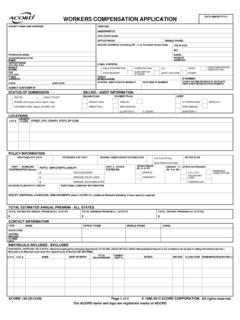Transcription of MATERIAL SAFETY DATA SHEET- EXXSOL D130 FLUID …
1 Page 1 of 8 MSDS - EXXSOL d130 FLUID MATERIAL SAFETY data sheet - EXXSOL d130 FLUID SECTION 1 PRODUCT AND COMPANY IDENTIFICATION PRODUCT Product Name : EXXSOL d130 FLUID Product Description : Dearomatised Hydrocarbons Intended Use : Solvent COMPANY IDENTIFICATION Supplier: PON PURE CHEMICALS GROUP CHENNAI, TAMILNADU, INDIA 24 Hour Health Emergency (91) 8939878447 (91) 9444038694 Transportation Emergency Phone (91) 9444038517 Company Name Place EMERGENCY TELEPHONE NUMBER Pon Pure Chemicals Group CHENNAI Day Emergency 044-26161803-26161809 This (M) SDS is a generic document with no country specific information included. SECTION 2 COMPOSITION / INFORMATION ON INGREDIENTS This MATERIAL is regulated as a complex substance. Hazardous Substance(s) or Complex Substance(s) Name CAS# oncentration* Symbols/Risk Phrases DISTILLATES, PETROLEUM, HYDROTREATED MIDDLE 64742-46-7 100% Xn;R65, R66 * All concentrations are percent by weight unless ingredient is a gas.
2 Gas concentrations are in percent by volume. SECTION 3 HAZARDS IDENTIFICATION This MATERIAL is considered to be hazardous according to regulatory guidelines (see (M) SDS Section 15). CLASSIFICATION: | Xn; R65 | R66 | PHYSICAL / CHEMICAL HAZARDS MATERIAL can release vapours that readily form flammable mixtures. Vapour accumulation could flash and/or explode if ignited. MATERIAL can accumulate static charges, which may cause an incendiary electrical discharge. HEALTH HAZARDS Harmful: may cause lung damage if swallowed. Repeated exposure may cause skin dryness or cracking. May be irritating to the eyes, nose, throat, and lungs. Note: This MATERIAL should not be used for any other purpose than the intended use in Section 1 without expert advice.
3 Health studies have shown that chemical exposure may cause potential human health risks which may vary from person to person. Page 2 of 8 MSDS - EXXSOL d130 FLUID SECTION 4 FIRST AID MEASURES INHALATION Remove from further exposure. For those providing assistance, avoid exposure to yourself or others. Use adequate respiratory protection. If respiratory irritation, dizziness, nausea, or unconsciousness occurs, seek immediate medical assistance. If breathing has stopped, assist ventilation with a mechanical device or use mouth-to-mouth resuscitation. SKIN CONTACT Wash contact areas with soap and water. Remove contaminated clothing. Launder contaminated clothing before reuse. EYE CONTACT Flush thoroughly with water. If irritation occurs, get medical assistance.
4 INGESTION Seek immediate medical attention. Do not induce vomiting. NOTE TO PHYSICIAN If ingested, MATERIAL may be aspirated into the lungs and cause chemical pneumonitis. Treat appropriately. SECTION 5 FIRE FIGHTING MEASURES EXTINGUISHING MEDIA Appropriate Extinguishing Media: Use water fog, foam, dry chemical or carbon dioxide (CO2) to extinguish flames. Inappropriate Extinguishing Media: Straight streams of water FIRE FIGHTING Fire Fighting Instructions: Evacuate area. Prevent run-off from fire control or dilution from entering streams, sewers or drinking water supply. Fire-fighters should use standard protective equipment and in enclosed spaces, self-contained breathing apparatus (SCBA). Use water spray to cool fire exposed surfaces and to protect personnel.
5 Hazardous Combustion Products: Incomplete combustion products, Smoke, Fume, Oxides of carbon FLAMMABILITY PROPERTIES Flash Point [Method]: >129C (264F) [ ASTM D-93] Flammable Limits (Approximate volume % in air): LEL: UEL: Auto ignition Temperature: 241 C (466 F) [Approximate] SECTION 6 ACCIDENTAL RELEASE MEASURES NOTIFICATION PROCEDURES In the event of a spill or accidental release, notify relevant authorities in accordance with all applicable regulations. PROTECTIVE MEASURES Avoid contact with spilled MATERIAL . See Section 5 for firefighting information. See the Hazard Identification Section for Significant Hazards. See Section 4 for First Aid Advice. See Section 8 for Personal Protective Equipment. Page 3 of 8 MSDS - EXXSOL d130 FLUID SPILL MANAGEMENT Land Spill: Stop leak if you can do so without risk.
6 Absorb or cover with dry earth, sand or other non-combustible MATERIAL and transfer to containers. Recover by pumping or with suitable absorbent. Water Spill: Stop leak if you can do so without risk. Warn other shipping. Remove from the surface by skimming or with suitable absorbents. Seek the advice of a specialist before using dispersants. Water spill and land spill recommendations are based on the most likely spill scenario for this MATERIAL ; however, geographic conditions, wind, temperature, (and in the case of a water spill) wave and current direction and speed may greatly influence the appropriate action to be taken. For this reason, local experts should be consulted. Note: Local regulations may prescribe or limit action to be taken.
7 ENVIRONMENTAL PRECAUTIONS Large Spills: Dyke far ahead of liquid spill for later recovery and disposal. Prevent entry into waterways, sewers, basements or confined areas. SECTION 7 HANDLING AND STORAGE HANDLING Avoid contact with skin. Use proper bonding and/or earthing procedures. Prevent small spills and leakage to avoid slip hazard. MATERIAL can accumulate static charges which may cause an electrical spark (ignition source). Loading/Unloading Temperature: [Ambient] Transport Temperature : [Ambient] Transport Pressure : [Ambient] Static Accumulator : This MATERIAL is a static accumulator. STORAGE Do not store in open or unlabelled containers. Keep container closed. Handle containers with care. Open slowly in order to control possible pressure release.
8 Store in a cool, well-ventilated area. Storage Temperature : [Ambient] Storage Pressure : [Ambient] Suitable Containers/Packing : Tank Trucks; Railcars; Barges; Drums Suitable Materials and Coatings: Carbon steel; Stainless steel; Polyethylene; Polypropylene; Teflon Unsuitable Materials and Coatings: Natural rubber; Butyl rubber; Ethylene-proplyene-diene monomer (EPDM); Polystyrene SECTION 8 EXPOSURE CONTROLS / PERSONAL PROTECTION EXPOSURE LIMIT VALUES Exposure limits/standards (Note: Exposure limits are not additive) Substance Name Form Limit/Standard Note Source Year DISTILLATES, PETROLEUM, HYDROTREATED MIDDLE Aerosol. TWA 5 mg/m3 ExxonMobil 2007 Exposure limits/standards for materials that can be formed when handling Page 4 of 8 MSDS - EXXSOL d130 FLUID this product: When mists / aerosols can occur, the following are recommended: 5 mg/m - ACGIH TLV, 10 mg/m - ACGIH STEL.
9 NOTE: Limits/standards shown for guidance only. Follow applicable regulations. ENGINEERING CONTROLS The level of protection and types of controls necessary will vary depending upon potential exposure conditions. Control measures to consider: Adequate ventilation should be provided so that exposure limits are not exceeded. PERSONAL PROTECTION Personal protective equipment selections vary based on potential exposure conditions such as applications, handling practices, concentration and ventilation. Information on the selection of protective equipment for use with this MATERIAL , as provided below, is based upon intended, normal usage. Respiratory Protection: If engineering controls do not maintain airborne contaminant concentrations at a level which is adequate to protect worker health, an approved respirator may be appropriate.
10 Respirator selection, use, and maintenance must be in accordance with regulatory requirements, if applicable. Types of respirators to be considered for this MATERIAL include: Half-face filter respirator Type P filters MATERIAL . For high airborne concentrations, use an approved supplied-air respirator, operated in positive pressure mode. Supplied air respirators with an escape bottle may be appropriate when oxygen levels are inadequate, gas/vapour warning properties are poor, or if air purifying filter capacity/rating may be exceeded. Hand Protection: Any specific glove information provided is based on published literature and glove manufacturer data . Work conditions can greatly affect glove durability; inspect and replace worn or damaged gloves.
